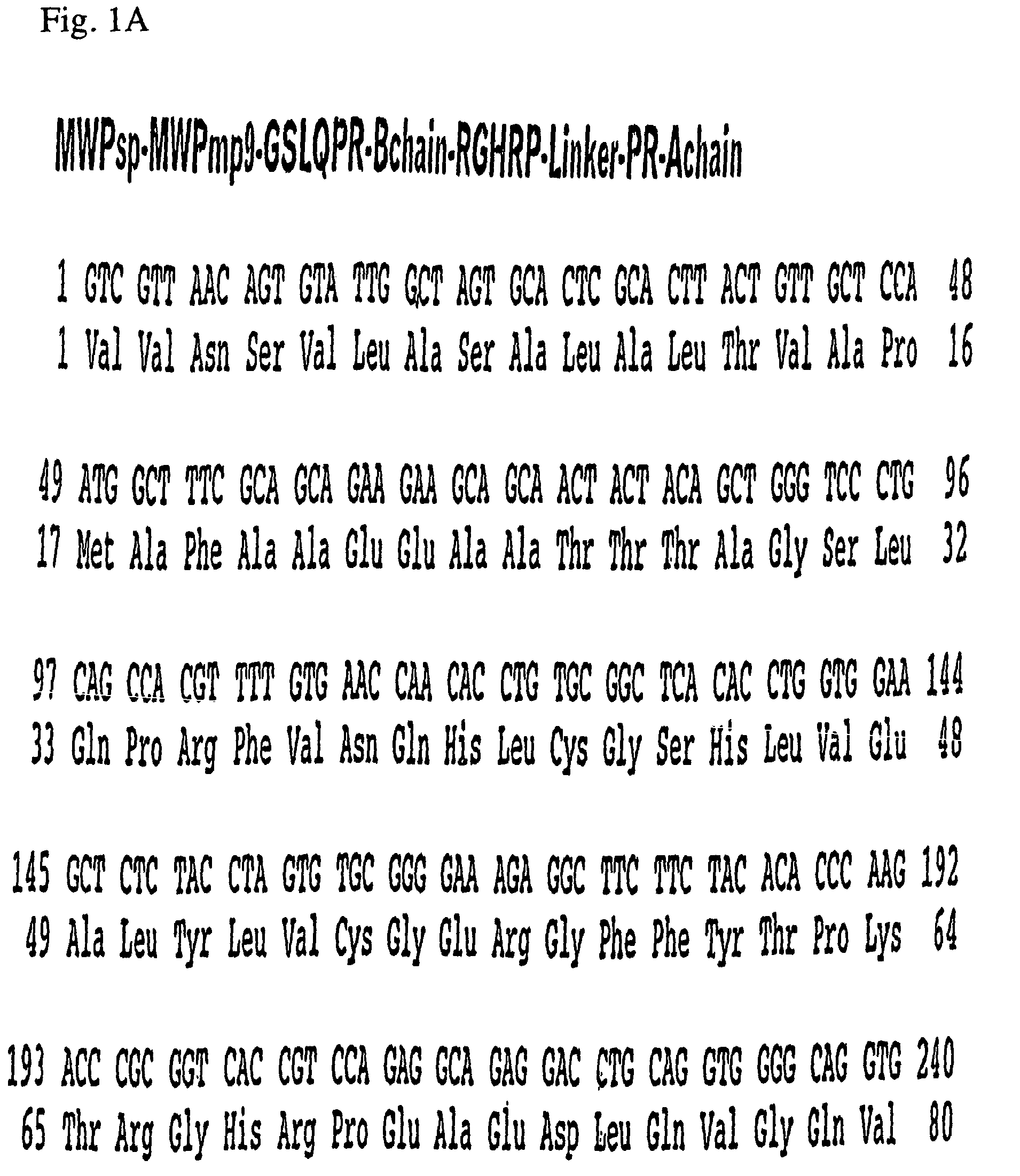Process for producing polypeptide having disulfide bond
- Summary
- Abstract
- Description
- Claims
- Application Information
AI Technical Summary
Benefits of technology
Problems solved by technology
Method used
Image
Examples
example 1
Construction of Vector (pmPINS) Having MWPsp-MWPmp9-GSLQPR-B Chain-RGHRP-Linker-PR-A Chain Fusion DNA Incorporated Therein
(1) Preparation of DNA Fragment, MWPsp-MWPmp9
a. Template DNA
[0048]Genome DNA (840 ng) was extracted from Bacillus brevis (strain 47-5Q) by a known method (Molecular Cloning 2nd ed., A Laboratory Manual, Cold Spring Harbor Laboratory (1989)).
b. Primer
Forward primer: 5′-ACACGCGCTTGCAGGATTCG-3′ (SEQ ID NO: 1)
Reverse primer: 5′-AGCTGTAGTAGTTGCTGC-3′ (SEQ ID NO: 2)
[0049]Primers were synthesized by organic chemical synthesis based on the nucleotide sequence of MWP protein determined by Yamagata, H. et al. (J. Bacteriol., 169, 1239–1245, 1987) and Tsuboi, A. et al. (J. Bacteriol., 170, 935–945, 1988). They were added at a final concentration of 0.1 μmol / L.
[0050]5 U of a commercially available product (GIBCO BRL) was added.
d. Others
[0051]Tris-HCl (final concentration of 20 mmol / L, pH 8), MgCl2 (final concentration of 2.5 mmol / L), dNTPs (dATP, dGTP, d...
example 2
Construction of Vector (pmPINS˜hPDI*) Having Fusion DNA, MWPsp-MWPmp9-GSLQPR-B Chain-RGHRP-Linker-PR-A Chain-MWPsp*-hPDI*, Incorporated Therein
(1) Preparation of DNA Fragment, MWPsp-MWPmp9-GSLQPR-B Chain-RGHRP-Linker-PR-A Chain
[0089]A blunt-ended DNA fragment, MWPsp-MWPmp9-GSLQPR-B chain-RGHRP-Linker-PR-A chain was Obtained by Procedures Similar to (1) of Example 1 except for the following procedures.[0090]As a template DNA, 10 ng of a plasmid vector having the DNA fragment, MWPsp-MWPmp9-GSLQPR-B chain-RGHRP-Linker-PR-A chain, incorporated therein was used.[0091]As a reverse primer, 5′-CTAGTTGCAGTAGTTCTCCAGCTGGTA-3′ (SEQ ID NO: 13) was used.[0092]PCR reaction conditions employed herein comprise a reaction cycle repeated 25 times, each cycle consisting of a denaturation temperature of 94° C. for 1 min, an annealing temperature of 53° C. for 1 min and a DNA strand elongation temperature of 72° C. for 30 sec.
(2) Preparation of DNA Fragment, Human Protein Disulfide Isomerase (hPDI)
[0093...
example 3
Expression and Secretion of Fusion DNA
(1) Amino Acid and Nucleotide Sequences of Fusion DNA
[0142]The amino acid sequence and the nucleotide sequence of the fusion DNA obtained in Example 1 corresponding to SEQ ID NOS: 24 and 25, respectively, are shown in FIG. 1A; the amino acid sequence and the nucleotide sequence (SEQ ID NO: 26) of the fusion DNA obtained in Example 2 are shown in FIG. 1B; and the amino acid sequence of the fusion protein, MWPsp*-hPDI* (FIG. 1B), is shown in SEQ ID NO: 27.
(2) Expression and Secretion of Fusion DNA
[0143]A fusion protein encoded by the fusion DNAs obtained in Examples 1 and 2 was expressed. A method for incorporating the fusion DNAs into an expression vector is shown in FIG. 2.
[0144]Specifically, the vector pmPINS, pmPINS˜hPDI* having the above fusion DNAs incorporated therein was treated with restriction enzymes ApaL I and Hind III, and then subjected to 0.8% agarose electrophoresis, thereby excising DNA fragments containing each fusion DNA. Approp...
PUM
| Property | Measurement | Unit |
|---|---|---|
| Fraction | aaaaa | aaaaa |
| Fraction | aaaaa | aaaaa |
| Fraction | aaaaa | aaaaa |
Abstract
Description
Claims
Application Information
 Login to View More
Login to View More - R&D
- Intellectual Property
- Life Sciences
- Materials
- Tech Scout
- Unparalleled Data Quality
- Higher Quality Content
- 60% Fewer Hallucinations
Browse by: Latest US Patents, China's latest patents, Technical Efficacy Thesaurus, Application Domain, Technology Topic, Popular Technical Reports.
© 2025 PatSnap. All rights reserved.Legal|Privacy policy|Modern Slavery Act Transparency Statement|Sitemap|About US| Contact US: help@patsnap.com



